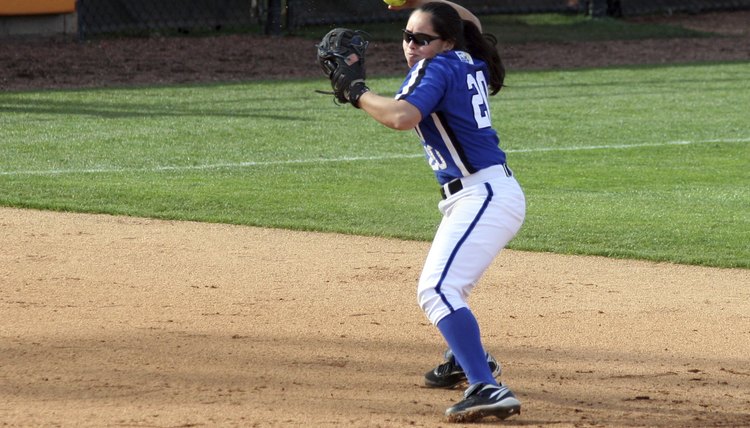Proper Mechanics of Throwing a Softball

Although softball pitchers throw underhand, the catcher and the rest of the defensive players behind the pitcher throw overhand, just like baseball players. As a softball player, then, it's essential that you learn how to execute the overhand throwing motion correctly, with proper mechanics. Doing so will help you throw accurately, maximize your throwing velocity and may help prevent throwing-related injuries. Consult an experienced softball coach or instructor for guidance.
Preparation Phase
The preparation phase begins after you catch the ball. Reach into your glove and grip the ball across the seams, if possible, with three or four fingers on top and your thumb underneath. Step toward your target with your throwing-arm-side foot and take the ball out of your glove simultaneously. Then, step toward your target with your glove-side foot, rotate your hips and shoulders backward, and swing your throwing arm backward and upward until it's slightly above shoulder height and pointed directly away from your target. Complete the arm swing slightly before your stride foot touches the ground. Swing your glove arm in the opposite direction at the same time so it points directly at your target.
Cocking Phase
The cocking phase of the softball throwing motion lengthens the muscles that inwardly rotate your upper arm and extend your elbow, preparing them to contract powerfully during the acceleration phase. Begin to rotate your hips and shoulders forward, squaring your chest to the target, and cock your arm by outwardly rotating your shoulder and flexing your elbow to about 90 degrees. Your elbow will point toward the target with your upper arm close to your ear if you execute the movement correctly.
Acceleration Phase
The acceleration phase follows immediately after the cocking phase and ends at release. The muscles that extend and inwardly rotate your shoulder, extend your elbow, flex your wrist, and pronate your forearm contract powerfully during this phase. As your throwing arm passes beside your ear, continue to extend your shoulder forward and begin inwardly rotating your shoulder and extending your elbow to accelerate the baseball forward. Flex your wrist once your elbow is almost fully extended, allowing the ball to fly off your middle finger toward your target. Allow your forearm to pronate, with the thumb-side of your hand twisting downward, after you release the ball.
Follow-Through Phase
The follow through occurs naturally after you release the ball. The same muscles that propelled the ball toward your target during the acceleration phase contract again to decelerate, or slow down, your arm and body. Allow the momentum of the throw carry your throwing-arm-side foot forward, in front of your glove-side foot, and let your throwing arm fall toward your glove-side leg. Avoid trying to "make" the follow through happen; it will happen correctly if you execute the first three phases properly.
References
- The Softball Drill Book; Kirk Walker
- Coaching Youth Softball; American Sport Education Program
Writer Bio
Matthew Schirm has worked in the sports-performance field since 1998. He has professional experience as a college baseball coach and weight-training instructor. He earned a Master of Science in human movement from A.T. Still University in 2009.
